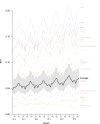Estimating the potential for global dissemination of pandemic pathogens using the global airline network and healthcare development indices
- PMID: 35197536
- PMCID: PMC8866520
- DOI: 10.1038/s41598-022-06932-y
Estimating the potential for global dissemination of pandemic pathogens using the global airline network and healthcare development indices
Abstract
Pandemics have the potential to incur significant health and economic impacts, and can reach a large number of countries from their origin within weeks. Early identification and containment of a newly emerged pandemic within the source country is key for minimising global impact. To identify a country's potential to control and contain a pathogen with pandemic potential, we compared the quality of a country's healthcare system against its global airline connectivity. Healthcare development was determined using three multi-factorial indices, while detailed airline passenger data was used to identify the global connectivity of all countries. Proximities of countries to a putative 'Worst Case Scenario' (extreme high-connectivity and low-healthcare development) were calculated. We found a positive relationship between a country's connectivity and healthcare metrics. We also identified countries that potentially pose the greatest risk for pandemic dissemination, notably Dominican Republic, India and Pakistan. China and Mexico, both sources of recent influenza and coronavirus pandemics were also identified as among the highest risk countries. Collectively, lower-middle and upper-middle income countries represented the greatest risk, while high income countries represented the lowest risk. Our analysis represents an alternative approach to identify countries where increased within-country disease surveillance and pandemic preparedness may benefit global health.
© 2022. The Author(s).
Conflict of interest statement
The authors declare no competing interests.
Figures


References
-
- International Working Group on Financing Preparedness. From Panic and Neglect to Investing in Health Security: Financing Pandemic Preparedness at a National Level. (World Bank, 2017).
-
- Moore, M., Gelfeld, B., Adeyemi Okunogbe, C. P. & Paul C. Identifying Future Disease Hot Spots. Infectious Disease Vulnerability Index. (2016).https://www.rand.org/pubs/research_reports/RR1605.html (RAND Corporation, Santa Monica, CA, 2016). - PMC - PubMed
Publication types
MeSH terms
Grants and funding
LinkOut - more resources
Full Text Sources
Medical

